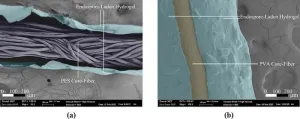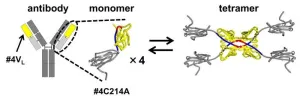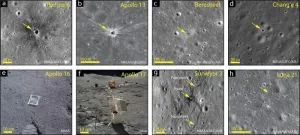New insights into Zebra mussel attachment fibers offer potential solutions to combat invasive species, develop sustainable materials
2023-12-08
(Press-News.org)
A recent study from researchers in Canada and Germany has revealed that an unlikely event, occurring over 12 million years ago played an important role in shaping one of Canada’s most damaging invasive species.
Zebra and quagga mussels, belonging to the Dreissenid family, are widespread freshwater invasive species throughout North America that present a significant danger to native ecosystems by competing for resources. Using a fibrous anchor called a byssus, Dreissenid mussels contribute to biofouling on surfaces and obstruct intake structures in power stations and water treatment plants.
“This new study, which looks into the way these mussels stick to surfaces, may help improve strategies against biofouling, a problem causing millions in damages in Canada alone” shares co-author and lead McGill Professor, Matthew Harrington.
Surprisingly, researchers discovered that a previously undocumented event contributed to Dreissenid mussel's resilience as a species. University of Göttingen Professor and co-author Daniel J. Jackson explains, "More than 12 million years ago, it is likely that a single bacterium transferred genetic material into a single mussel endowing its descendants with the ability to make these fibers. Given their crucial role in mussel attachment in freshwater habitats, this horizontal gene transfer event supported the harmful global expansion of these mussels.”
This research, marking important progress in the understanding of invasive mussels and their attachment mechanisms, could offer potential solutions to mitigate their environmental and economic impact in Canada.
The study also sheds light on how mussel fibres could inspire the development of sustainable materials.
Sustainable materials inspired by mussel biology
“This research not only advances our understanding of mussel evolution and biofouling, but also presents an exciting opportunity for the development of novel materials,” said Harrington who is also co-director of McGill Institute of Advanced Materials. "Dreissenid byssus fibers, which resemble spider silk structurally, could inspire future development of tough polymer fibers, contributing to more durable and sustainable materials typically used in textiles and technical plastics.”
“We found that the building blocks of the fibres are massive coiled-coil proteins, the largest ever found,” Harrington said. These proteins, structurally similar to those found in human hair, were found to transform into silk-like beta crystallites through simple application of stretching forces during formation. This method of fiber fabrication is much simpler than spider silk formation, potentially offering an easier route toward biotechnological manufacture of sustainable fibers – an industry currently dominated by artificial spider silks.
About this study
“Invasive mussels fashion silk-like byssus via mechanical processing of massive horizontally acquired coiled coils” by Matthew Harrington et al., was published in PNAS.
https://www.pnas.org/doi/full/10.1073/pnas.2311901120
END
ELSE PRESS RELEASES FROM THIS DATE:
2023-12-08
EPFL researchers have developed a hybrid device that significantly improves existing, ubiquitous laser technology.
The team at EPFL’s Photonic Systems Laboratory (PHOSL) has developed a chip-scale laser source that enhances the performance of semiconductor lasers while enabling the generation of shorter wavelengths. This pioneering work, led by Professor Camille Brès and postdoctoral researcher Marco Clementi from EPFL’s School of Engineering represents a significant advance in the field of photonics, with implications for telecommunications, metrology, and other high-precision applications.
The ...
2023-12-08
SAN ANTONIO – Patients with low-risk ductal carcinoma in situ (DCIS) who skipped adjuvant radiotherapy after breast-conserving surgery had comparable five-year outcomes to those with high-risk DCIS who received adjuvant radiotherapy, according to results from the E4112 clinical trial presented at the San Antonio Breast Cancer Symposium, held December 5-9, 2023.
“Nearly all women with DCIS—a noninvasive form of breast cancer—will have their cancer successfully removed, but some women will have a high risk of the disease returning or progressing to invasive breast cancer,” said Seema A. Khan, MD, a professor of surgery and the Bluhm Family ...
2023-12-08
Women 50 or older who de-escalated to less-frequent mammography three years after curative surgery for early-stage breast cancer had similar outcomes to women who received annual mammography, according to results from the Mammo-50 trial presented at the San Antonio Breast Cancer Symposium, held December 5-9, 2023.
Both U.S. and U.K. guidelines recommend annual breast cancer screening following surgery to remove early-stage breast cancer; in the U.S., annual mammography is recommended indefinitely, and in the U.K., it is recommended for five years, followed by screening every three years for patients 50 years and older.
However, the optimal screening schedule has yet to ...
2023-12-08
SAN ANTONIO – Comprehensive profiling of fusion RNAs present in a large cohort of metastatic breast tumors revealed unique fusion mutations that may be therapeutically targetable, according to results presented at the San Antonio Breast Cancer Symposium, held December 5-9, 2023.
Fusion mutations occur when a portion of one gene becomes fused to a portion of another, which can create gene products with new functions. They are common in cancer types that are characterized by genomic rearrangements and structural damage to the DNA, including breast cancer.
“Fusion RNAs may serve as ...
2023-12-08
Data from Australian researchers could partly explain why a trial of a new drug for diabetes, was recently halted because it was found to be so effective. Importantly, the data also reveals how anti-obesity drugs like Ozempic, actually work, which to date have been a mystery.
In early November the FLOW trial of the drug semaglutide on the progression of renal impairment in people with type 2 diabetes and chronic kidney disease was halted ahead of schedule because of the drug’s efficacy.
Part of the rationale for the cessation of the trial could be explained by ...
2023-12-08
With the increase in the production of batteries for electric vehicles, demand is also rising for the necessary raw materials. In view of risks to the supply chain, environmental problems and precarious working conditions which are all associated with the mining and transportation of these materials, the recycling of battery materials has become an important issue in research, politics and industry. Prof. Stephan von Delft from the University of Münster (Germany) heads a team of researchers from the fields of science ...
2023-12-08
In hopes of producing concrete structures that can repair their cracks, researchers from Drexel University’s College of Engineering are putting a new twist on an old trick for improving the durability of concrete. Fiber reinforcement has been around since the first masons were mixing horsehair into their mud. But the Drexel research team is taking this method to the next level by turning reinforcing fibers into a living tissue system that rushes concrete-healing bacteria to the site of cracks to repair the damage.
Recently reported in the journal Construction ...
2023-12-08
Ikoma, Japan – Antibodies (immunoglobulins) are Y-shaped proteins that recognize and neutralize specific pathogens. Their ability to target specific molecules or cells has made them promising candidates for future drug development. However, their light chains—parts of the antibody that contribute to recognizing and binding to specific antigens—misfold and aggregate, leading to amyloidosis, a condition that brings about complications and tissue dysfunction in the body. In the context of drug development, antibody aggregation can compromise their capacity to bind to antigens ...
2023-12-08
LAWRENCE — Human beings first disturbed moon dust on Sept. 13, 1959, when the USSR’s unmanned spacecraft Luna 2 alighted on the lunar surface. In the following decades, more than a hundred other spacecraft have touched the moon — both crewed and uncrewed, sometimes landing and sometimes crashing. The most famous of these were NASA’s Apollo Lunar Modules, which transported humans to the moon’s surface to the astonishment of humankind.
In the coming years, missions and projects already planned will change the face of the moon ...
2023-12-08
Two-dimensional materials, which are only a few atoms thick, can exhibit some incredible properties, such as the ability to carry electric charge extremely efficiently, which could boost the performance of next-generation electronic devices.
But integrating 2D materials into devices and systems like computer chips is notoriously difficult. These ultrathin structures can be damaged by conventional fabrication techniques, which often rely on the use of chemicals, high temperatures, or destructive processes like etching.
To overcome this challenge, researchers from MIT and elsewhere have developed a new technique to integrate 2D materials into devices in a single ...
LAST 30 PRESS RELEASES:
[Press-News.org] New insights into Zebra mussel attachment fibers offer potential solutions to combat invasive species, develop sustainable materials



